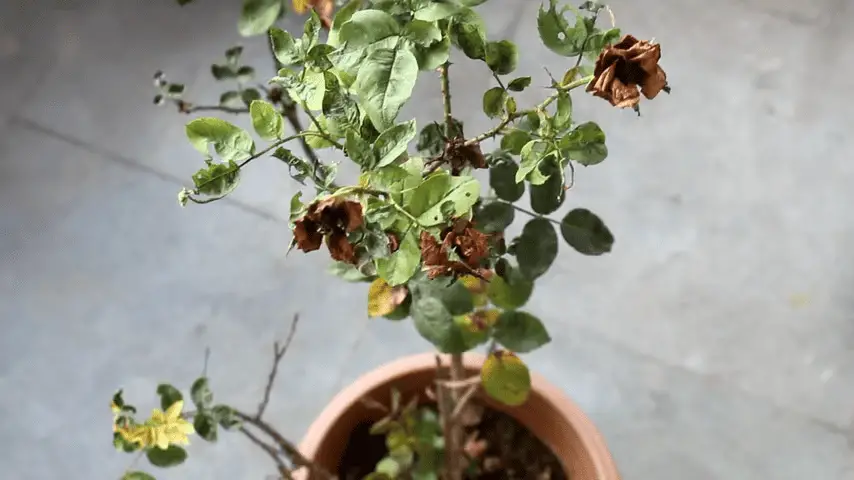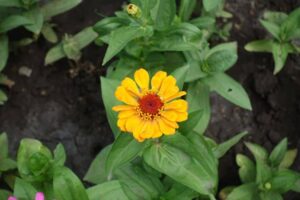
Are the leaves on your rose bushes tightly coiled or rolled inward? If so, you may be wondering, “Why are my rose leaves curling?”. Curling rose leaves can be distressing for avid gardeners. There are several potential reasons why rose leaves may curl.
The most common cause of rose leaf curling is environmental stress, which can be caused by too much sun, too little sun, too much or too little water, too much fertilizer, or a few other reasons.
However, once the cause is identified, you can ensure that your rose is getting the proper care it needs to flourish.
So, without further talk, let’s learn how to identify the cause of curled leaves and take steps to prevent further damage.
Reasons for Curled Rose Leaves

1. Lack of water:
One of the most common causes of curled rose leaves is lack of water. Roses need regular watering to stay hydrated. During periods of drought or heatwaves when outdoor watering is not sufficient, rose leaves may start curling as a protection mechanism against dehydration.
2. Pest Infestation:
Certain pests like aphids, whiteflies, spider mites, and thrips can cause leaf curling in roses. These sap-sucking insects feed on the undersides of leaves, depositing toxins and causing deformation. Leaves may curl inward as a response.
3. Fungal or Bacterial Disease:
Diseases caused by fungi, bacteria, or viruses can also result in curled rose leaves. Common fungal diseases include blackspot, powdery mildew, and rust. Leaves get misshapen as the pathogens invade the plant tissues.
4. Nutritional Deficiencies:
Lack of important nutrients like nitrogen, potassium, or magnesium in the soil can indirectly induce leaf curling in roses. Nutrient-deficient plants are more susceptible to other stresses.
5. Temperature Fluctuations:
Rapid changes in temperature, especially warmer days followed by cooler nights, can confuse roses. Leaves may curl as a protective response until a stable climate is restored.
6. Herbicide Drift:
Nearby application of certain herbicides can drift over and damage rose plants through leaf contact. This may cause leaf distortion initially and curling over time.
7. Genetics:
Some rose varieties are naturally prone to curled leaves depending on their genetic makeup. Certain hybrids are just wired that way.
Solutions for Curling Rose Leaves

Once the underlying cause is determined, here are some solutions to address curled rose leaves:
1. Improve Watering:
During droughts or heatwaves, water roses deeply at least once a week. Consistent moisture helps prevent leaves from wilting.
2. Treat Pest Infestation:
Use neem oil, insecticidal soaps or approved pesticides to get rid of aphids and mites. Reapply as per the label after rain.
3. Apply Fungicides:
Spray leaves with copper fungicide or similar products mentioned on labels when fungal diseases are suspected. Repeated applications may be required.
4. Fertilize Regularly:
Roses love nitrogen, phosphorus, and potassium. Apply balanced, water-soluble fertilizer every 4-6 weeks during the growing season.
5. Remove Deformed Leaves:
Prune away severely curled leaves to allow new growth. Sanitize pruning shears after each use.
6. Provide Protection from Elements:
Shade plants or use row covers on hot afternoons. Grow windbreak-loving varieties in sheltered spots.
7. Check for Nutrient Deficiencies:
Conduct soil tests. Apply specific fertilizers, compost, or calcified seaweed to remedy the lack of nutrients in soilless media.
8. Choose Appropriate Varieties:
Consider growth habits and climatic needs before selecting rose varieties to avoid genetic predisposition to leaf curl.
9. Apply Mulch:
Organic mulches help regulate soil temperature and retain moisture. This stabilizes growing conditions for roses.
With regular care and following these steps, curled rose leaves should improve within a few weeks, and healthy new growth should emerge. Persistent issues may require assistance from local extension experts.
When to be Concerned about Curling Rose Leaves
While some leaf curling is normal and not a cause for major concern, there are situations where it is important to take action:
- Severe Curling: If leaves are tightly curled into tubes or balls, it could indicate a pest infestation or disease that requires treatment.
- All Leaves Affected: Uniform curling of leaves across the entire plant suggests a nutritional, environmental or genetic issue that needs addressing.
- Stunted Growth: Along with extremely curled leaves, failing to see new shoots emerge may mean the plant is under undue stress.
- Unusual Symptoms: Leaf spots, discolouration or shedding along with curling could point to a more serious underlying problem.
- Spread to Other Plants: If symptoms are appearing on surrounding roses and landscape plants, it might be a highly contagious disease needing containment.
In these cases, it is advisable to take cuttings for propagation, remove affected leaves, isolate the plant and identify/treat the problem without delay. Consult experts if in doubt.
How to Prevent the Rose Leaf Curling
An ounce of prevention is worth a pound of cure. Taking good care of rose bushes right from the start can help reduce the risk of leaves curling in future:
- Plant roses in fertile, well-draining soil amended with organic matter like compost.
- Water deeply but infrequently based on weather and soil moisture levels.
- Fertilize roses every 4-6 weeks during the growing season with balanced, water-soluble plant food.
- Use mulch to regulate soil temperature and moisture levels around the plants.
- Inspect leaves regularly and treat any pests at the first signs of infestation.
- Prune bushes after flowering to promote air circulation and reduce disease spread.
- Select disease-resistant rose varieties suitable for the local climate whenever possible.
- Rotate crops and avoid planting roses in the same spot for more than 3 years.
- Improve ventilation around clustered rose plantings to limit humidity.
- Respect application guidelines for any pesticides or herbicides used near roses.
Frequently Asked Questions
Can rose leaf curl be prevented entirely?
Answer: While diligent care practices can minimize risks, some curling may still occur periodically due to natural causes beyond our control, like fluctuations in climate and genetics. The goal should be maintaining overall plant health and vigour to withstand occasional stresses.
How long will it take new growth to emerge after treating curled leaves?
Answer: This may vary depending on the plant’s responsiveness, but in favourable conditions, new shoots may become visible within 10-14 days. Give it 4-6 weeks before concluding if the treatment was effective. Be patient, as regrowth takes time and energy from the roots.
What should I do if curling persists despite my best efforts?
Answer: If leaves continue to curl even after addressing the cause(s) and the solutions don’t show results within 2-4 weeks, the plant could be severely stressed. As a last resort, prune back to fresh wood and allow regrowth from the base. Consider replacing the rose bush if issues reoccur next season.
Conclusion
With diligent care and cultural practices like these, curled leaves ought not to trouble rose plants often, if at all. But early detection and prompt action remain the keys when issues do arise occasionally. Healthy, vigorously growing bushes will be rewarded with an abundance of lovely blooms season after season. Let us know if you have any other questions!







One Comment